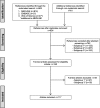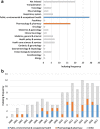Bias in pharmacoepidemiologic studies using secondary health care databases: a scoping review
- PMID: 30871502
- PMCID: PMC6419460
- DOI: 10.1186/s12874-019-0695-y
Bias in pharmacoepidemiologic studies using secondary health care databases: a scoping review
Abstract
Background: The availability of clinical and therapeutic data drawn from medical records and administrative databases has entailed new opportunities for clinical and epidemiologic research. However, these databases present inherent limitations which may render them prone to new biases. We aimed to conduct a structured review of biases specific to observational clinical studies based on secondary databases, and to propose strategies for the mitigation of those biases.
Methods: Scoping review of the scientific literature published during the period 2000-2018 through an automated search of MEDLINE, EMBASE and Web of Science, supplemented with manually cross-checking of reference lists. We included opinion essays, methodological reviews, analyses or simulation studies, as well as letters to the editor or retractions, the principal objective of which was to highlight the existence of some type of bias in pharmacoepidemiologic studies using secondary databases.
Results: A total of 117 articles were included. An increasing trend in the number of publications concerning the potential limitations of secondary databases was observed over time and across medical research disciplines. Confounding was the most reported category of bias (63.2% of articles), followed by selection and measurement biases (47.0% and 46.2% respectively). Confounding by indication (32.5%), unmeasured/residual confounding (28.2%), outcome misclassification (28.2%) and "immortal time" bias (25.6%) were the subcategories most frequently mentioned.
Conclusions: Suboptimal use of secondary databases in pharmacoepidemiologic studies has introduced biases in the studies, which may have led to erroneous conclusions. Methods to mitigate biases are available and must be considered in the design, analysis and interpretation phases of studies using these data sources.
Keywords: Administrative claims; Bias; Confounding factors; Electronic health records; Medical record linkage; Medical records; Observational studies; Pharmacoepidemiology.
Conflict of interest statement
Ethics approval and consent to participate
Not applicable.
Consent for publication
Not applicable.
Competing interests
The authors declare that they have no competing interests.
Publisher’s Note
Springer Nature remains neutral with regard to jurisdictional claims in published maps and institutional affiliations.
Figures




References
-
- Hennessy S. Use of health care databases in pharmacoepidemiology. Basic Clin Pharmacol Toxicol. 2006;98:311–313. - PubMed
-
- Ray WA. Improving automated database studies. Epidemiology. 2011;22:302–304. - PubMed
-
- Schneeweiss S, Avorn J. A review of uses of health care utilization databases for epidemiologic research on therapeutics. J Clin Epidemiol. 2005;58:323–337. - PubMed
-
- European Commission. Regulation (EU) 2016/679 of the European Parliament and of the council of 27 April 2016 on the protection of natural persons with regard to the processing of personal data and on the free movement of such data, and repealing directive 95/46/EC (general data protection regulation). 2016. http://eur-lex.europa.eu/eli/reg/2016/679/oj. Accessed 8 Oct 2018.
-
- U.S. Department of Health and Human Services. Code of Federal Regulations. Title 45 Public Welfare. Part 46 Protection of Human Subjects. 2016. https://www.hhs.gov/ohrp/regulations-and-policy/regulations/45-cfr-46/in.... Accessed 8 Oct 2018. - PubMed
Publication types
MeSH terms
LinkOut - more resources
Full Text Sources
Medical

